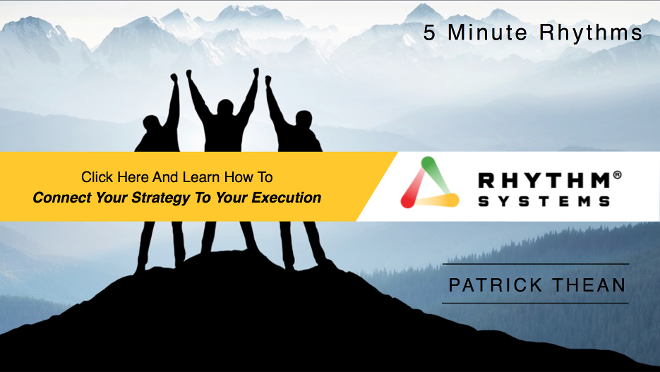Strategy without Tactics is the slowest route to victory. 
Tactics without Strategy is the noise before the defeat.
- Sun Tzu
Do you ever wonder why all those great plans you create don’t really come to full fruition? What happens? Where did all those great ideas go? Why did one or two of them do okay, but the rest of them just didn’t ever evolve?
In my 25 years of consulting with mid-market growth companies, I’ve worked with great planners who create beautiful strategies for growth but they get eaten alive by their day jobs, which creates a struggle when it comes to implementation of their plan. And, I’ve worked with great tacticians who are amazing managers of day-to-day operations and all the daily tasks that need to get done, but they struggle when it comes to focusing on the bigger picture of their overall strategic intent. Then, there are companies that create the semblance of a plan with some loosely woven tactics to support it, but not much ever launches.
As a result, there’s a lot of frustration, feelings of self-defeat, wandering thoughts, lack of focus, and in time lack of any clarity at all. The natural inclination is to just dwindle back to doing the day-to-day work we’ve always done. And indeed, the ‘day job’ stuff is like a magnet! It will suck you in almost at will and when that happens, literally everything reverts back to day-to-day tactics.
The question becomes, then: How do we get a grip on this? How do we get better at pulling these two ends of the strategic spectrum together?
Here are 5 tips to help you get a grip on your strategy:
- 1. Get a Grip on Three Key Things: (a) What do we want to be when we grow up? (This is your longer-term vision.) (b) Based on our vision, then, where do we want to be in 3 to 5 years? What will the company look like? What will it be known for? What will make us proud to have accomplished? From this discussion, then, what are three to five revenue-injecting Winning Moves we should accomplish? (c) What, specifically, do we need to start doing today to build the bridge toward our future? What Annual Initiatives should we get done this year? This discussion is important as it helps you know where you want to play! When life calls on you to be adaptive (which it will), you’re better ready to know which direction you need to go. Without a strategic framework, you simply make decisions on what seems like a good idea at the time. It’s the robust discussions in your Annual Planning Sessions and a weekly meeting that make the difference.
- 2. Get a Grip on Specificity. What does “To Be the Best!” mean? What does “To Be Customer Focused” mean? Hash it out; define it; create measurements to identify it. Discuss: How does it serve your Brand? Or, “Attend five conferences this year!” Push yourself on metrics by asking, “So what will be the business result of having attended these five conferences?” I once worked with an executive team who was really concerned about sales. They couldn’t get their head of sales to share his ‘sales report,’ which a prior head of sales had always done. The team had requested it, but they openly shared that what they get is just a vague report. Therefore, during their Annual Planning Session, they asked their head of sales to produce such a report for their review within one month. He agreed, and they were all ready to move forward. But no—they weren’t ready to move forward. There were no specifics around their expectations for what they wanted to see in that report. So we took the time to outline the specifics: What, specifically, do you want this sales report to contain? We ended up with a robust and detailed outline and in the end it was clear that without these specific expectations having been clearly expressed, the battle would have continued (and the battle really isn’t fair to anyone; they’d been causing their own frustration for an entire year due to just asking for a ‘report’ that never seemed to meet their expectations.) Their head of sales was thrilled, as he had no idea what they wanted from him, or why they even wanted it. Now, he was clear. If you don’t get a grip on specifics, your strategy will have the consistency of Jello (and there’s not really a good way to get a solid grip on Jello).
- 3. Get a Grip on What Success Looks Like. Set Success Criteria for everything. Whenever possible, stay away from due dates as success criteria. Someone can produce something by a due date, but it doesn’t mean that what was produced is any good.
- 4. Get a Grip on Transparency. Use a Dashboard to track your progress, and status it each week. Rhythm Systems likes to look at every quarter as a 13 Week Race. You have 13 weeks, then, to get the ball rolling in the right direction. If you don’t track your strategic initiatives, then your strategic intent gets lost in the wilderness of day-to-day, tactical work. Our clients status the Rhythm Dashboards weekly, then review their Dashboard routinely each week. Their Weekly Adjustment Meetings, then, are designed to solve problems, issues, and challenges vs. merely talking about operational items or the status of things. As one client put it: “Because we use the Rhythm Dashboard at the executive level (and we’ve cascaded it down to the next level as well), no one can hide. It keeps us out of the weeds and more in line with what we strategically want to accomplish in order to continue growing this amazing company of ours!” (Here’s a glimpse of the Rhythm Dashboard.)
- 5. Get a Grip on the Real Value of “Strategic Planning.” In MIT Sloan Management Review, Sarah Kaplan and Eric Beinhocker describe their in-depth study of companies who do strategic planning. Ultimately, their study shared that while important (for a number of reasons), coming up with a plan allowed the team to also learn. Consider thinking, then, of your strategic planning process as a journey vs. as a time to get together and plan. Position it to your team as a learning tool that quite by its very nature creates “prepared minds” (to paraphrase Louis Pasteur). By doing this, leaders at all levels are better prepared to make strategic decisions when they crop up in real-time. They’re better able to adjust within a framework vs. grasping at straws. They’re more adaptable and flexible (since most plans simply don’t follow a strictly written script; as much as we might like for life to follow a script, it rarely does). They’re better able to create line of sight around ‘why’ they’re doing what they’re doing today—and how those activities feed the soul of the company. So create the mindset in your company to be a Learning Organization, and use your planning sessions to create incredible plans that allow your company to live, breath, grow, and learn.
Once you know what you want to do (your Strategy), you can create focused and aligned Individual Priorities and Actions (your Tactics) to get there. Your strategic discussions allow you to make choices about your company’s future growth and the direction of that growth, and the right kinds of specifics, a healthy culture of collaboration, and framing your planning sessions as learning opportunities set the stage for you to get a tight grip on a proactive approach to your work. Strategies and Tactics allow you to make good choices in real-time, while also keeping everyone in your company focused, aligned, and clear on the value of their work.
Photo Credit: iStock by Getty Images




